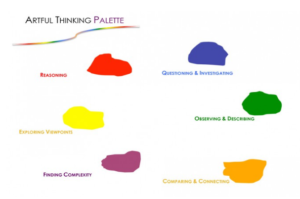I have a confession to make: I haven’t always been interested, open, or curious about math. In fact I hated it. I was your typical humanities teacher who stayed in my lane, despite having awesome partner teachers who tried to pull me over to the dark side and collaborate with them on projects. Underneath my disinterest was many years of pain, humiliation and confusion in math. However, as I learned to let my guard down and listen and learn from some math Greats, I realized that math didn’t need to continue to be that way for me and surely didn’t need to be that way for children today.
Stacy Jennings is one of those “greats” who has led some session at #DesignCamp and the Deeper Learning Conference on learning about math through art. Admittedly, I walked past her session to see how scary she and the participants looked, only to find a harmless room and a few smiles. I sat down and here is what I learned…
Shifting Mindset
You can get at math through the backdoor! Stacy shared with us the ways in which she uses Artful Thinking Routines in her classroom to teach students not only about math, but critical thinking, dialogue, the arts and ELA. What I loved about this “back door approach” was that it was low barrier, easy entry-meaning you didn’t even realize you were being walked into a math problem until you were discussing math concepts and applying them in your own creation.
She worked this magic by walking us through these simple steps:
- Throwing up some art work on the screen and asking us to describe what we saw through basic, concrete observations, analyze artistic elements we saw, connect to math with specific support for our connections and claims, and ultimately, extend and create by drawing our own ideas.
For an individual like myself, and so many students, who struggle with developing an academic mindset in math this was an empowering experience. There were no wrong answers, which created a safe space to try. I was able to see myself doing math successfully, I felt as though I had something to offer the conversation, and I gained a bit of confidence. This was all because math was approached from a completely organic and student-centered approach.
There are so many different ways to extend this approach to math-crossing over into other content areas, what students create, math talks, creating writing, oh my! Kudos to you Stacy and other folks like @jimConway who have been thinking this way for a while, continue to learn and grow with it, and shares with the rest of us so we can learn from you! What other ways can shift our students from a fixed mindset to a growth mindset? Please comment and share tips from your craft with your colleagues in the CraftED Community and connect with us via Facebook, Pinterest and Twitter.

